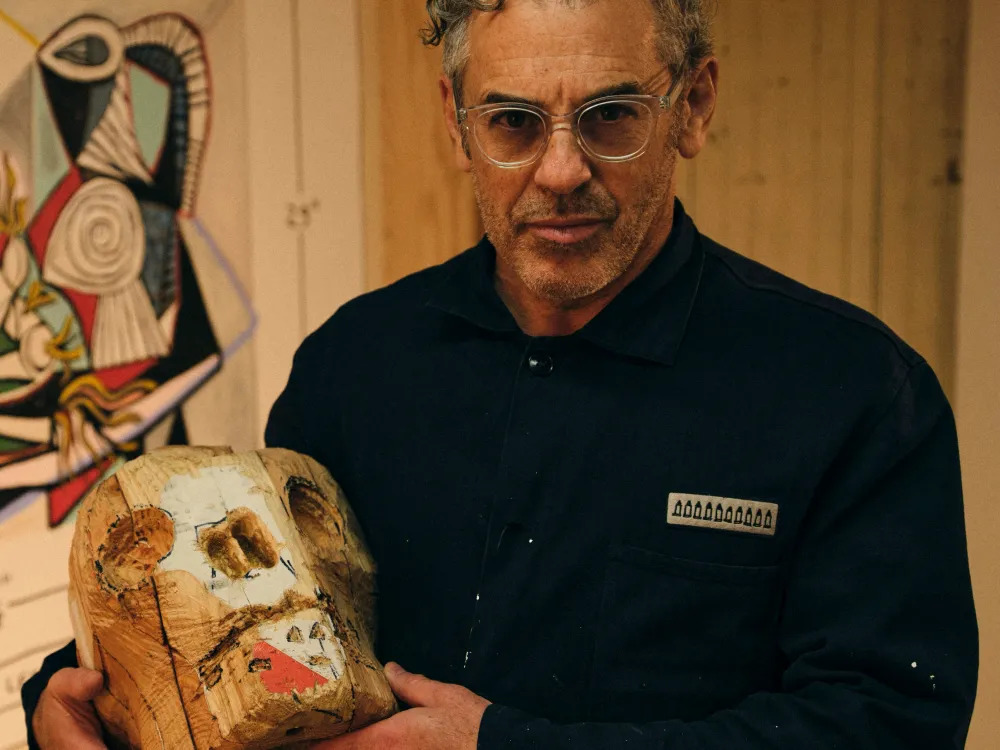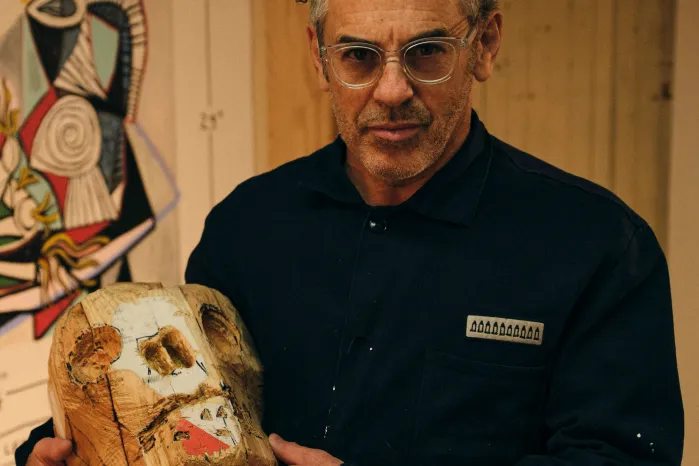
Earlier this month, during Frieze Week, Tom Sachs was dishing out espressos and 86-proof mezcal from behind a bar at Thaddaeus Ropac’s London outpost on Dover Street. The American artist was launching his new show, “A Good Shelf” (on view through December 20), featuring 30 NASA-emblazoned ceramics inspired by Japanese tea bowls (chawans), ritual, bricolage, and space travel.
Sachs had earned a stiff drink after a trying couple of years: in 2023, former studio staff accused the artist of creating a toxic workplace environment, including allegations of sexual harassment, bullying, and inadequate pay. In the aftermath, Nike paused its sneaker partnership with Sachs—only to restart it in February. Now, the artist is back at the coalface, working as intensely as ever, with several international projects in the pipeline. Earlier this year he made work for another exhibition at Ropac’s Seoul outpost that scrutinized Pablo Picasso.
Only a handful of living artists operate on Sachs’s scale, commanding a studio team that realizes ambitious, large-scale visions. Sachs, 59, whose auction record was set at just over $300,000 for his Tiffany Value Meal (1998) at Christie’s New York in 2022, is one of them. His oeuvre includes a life-size replica of the Apollo lunar excursion module for his “Space Program” series, a Chanel-branded guillotine (Chanel Guillotine [Breakfast Nook], 1998), and a 17-foot-long foamcore sculpture titled Unité (2001). The latter, a commentary on the commercialization of high modernism, is in the Guggenheim Museum’s permanent collection. His current show at Ropac continues themes from his 2012 exhibition “Space Program: Mars Mission,” when he created a bricolage version of the traditional Japanese tea ceremony—reimagined for the red planet.
The hand-formed ceramics in “A Good Shelf” symbolize Sachs’s pursuit of perfection, the balance of control and intuition, and the gradual relinquishing of artistic identity.
“Ceramics, without doubt, is the most complex of all crafts,” Sachs told ARTnews. “At almost 60 years old, I’ve dabbled in every possible craft. Ceramics is the most technically advanced. It involves the most error, science, and chemistry. In my hand-building, I’m always striving toward my ideal [artist], who is the 16th-century potter Chōjirō, the founder of Raku-ware [a type of Japanese pottery traditionally used in tea ceremonies]. As I get better, I’m giving up my character, because my ceramics are losing some of the identity and crappiness of being made by an individual.”
Each ceramic in the exhibition is embossed with “NASA” and the fingerprints of its maker. The works are deeply personal as a result, and displayed on shelves made from rough fragments of materials like cinderblock, polystyrene, and plywood. Sachs described himself as a “black belt in bricolage.” He said that, occasionally, perfection in sculpture arrives almost by accident.
“I have found a level of mastery in many areas, like when I make models or sculptures of pre-existing things in the wrong material and the wrong scale,” he said. “Whether that’s a Hermès Kelly bag or a lunar module, I found a way that is authentically mine, a way that makes it look like it was made in a factory despite being made by hand. I think the language of sculpture I’ve developed over the last 40 years is well established, whereas with ceramics, I’m still learning and struggling—but through repetitive work, innovation happens accidentally.”
The element of ritual in “A Good Shelf” is central for Sachs, who said he begins each day by making a ceramic before checking his phone. The act, he explained, pulls him away from the digital grind and into his practice—a vital channel for a self-professed utilitarian obsessed with function and purpose.
“In the studio, we say, ‘creativity is the enemy,’ and I mean that quite seriously. It’s like chili pepper—you don’t need a lot to give spice to what you’re doing, and too much ruins the sauce. You need a high percentage of pure hard [work], just showing up every day,” he explained. “And then, in the 99 percent of the time you spend making a sculpture or digging a ditch, the mind wanders, yet it is anchored through the action of work. And work becomes like a meditation. That’s when innovation and accident occur—like genetic mutations in nature. It’s mostly the same animal being reproduced generation after generation, yet genetic changes occur through accident that give it a better chance of survival. That’s how slime evolved over billions of years into creatures that discuss slime. Creativity is about sticking with your guns and spending a lot of time at the table.”
Upsilon Is the Latest Gallery to Try the Fast-Growing Milan Market
Newly Discovered Microsnail Named After Picasso

A Comedian and an Heiress Have Put Their Vintage L.A. Mansion on the Market at $22 Million

If Labubus Are Out, Beauty Bag Charms Are In — Here Are the 8 Best Ones We Recommend Buying

The Dodgers Aren’t ‘Ruining Baseball’—They Have Plenty of Help


